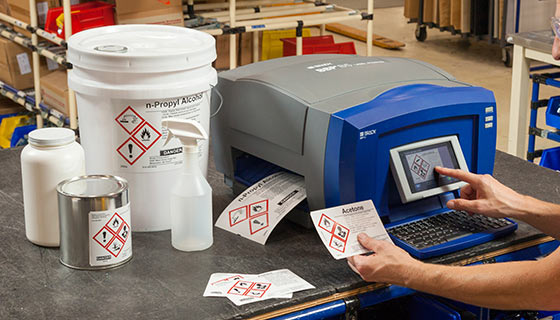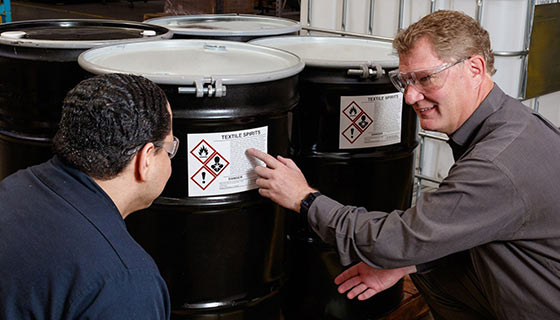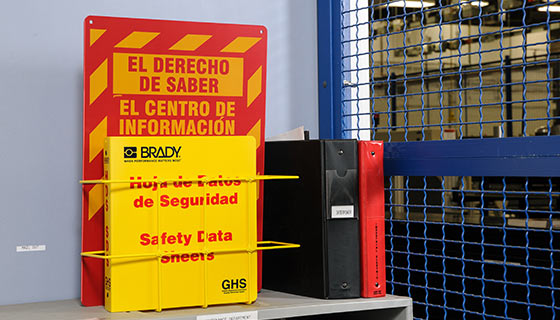Labels for Safety, Visuals and Facility ID Desktop Printers
Labels for Product, Wire and Lab ID Benchtop Printers
Labels for Safety, Visuals and Facility ID Desktop Printers
Labels for Product, Wire and Lab ID Benchtop Printers
Safety and Facility ID Desktop Printers
Product, Wire and Lab ID Benchtop Printers
Barcode Scanner and Printer Kits
Barcode Scanner and Printer Kits
PaintStripe Floor Marking Stencils
Valve Lockouts & Hose Lockouts
Group Lock Boxes & Permit Control
Brady Safety Lockout Tagout Services
Pipe Marker Accessories & Mounting Brackets
Maintenance and Production Tags
Calculators and Assessment Tools
Product Finders and Data Sheets
The modern workplace is constantly evolving. New hazards are identified. Safety standards are amended. Methods are improved. And with those shifts, the ways we communicate about workplace safety standards must evolve as well.
The current state of workplace safety is a far cry from that of the late nineteenth and early twentieth century, during which American workers in particular had to deal with significant hazards on a regular basis. Many of these hazards sprang from the large-scale introduction of machinery without the complementary introduction of new safety protocols. In fact, until relatively recently in our history, employers had little incentive to prioritize workers’ safety, and injured workers had few options for legal recourse. While patchwork regulations specific to state and industry cropped up throughout the twentieth century, no widespread, federal oversight was implemented until the establishment of OSHA in 1970.
However, this is not to say that there is no room for improvement in modern American workplaces. As our workplaces experience yet another significant, technological transformation in the modern day, hazard communication protocols must evolve along with them. If they don’t, we risk repeating the historical calamity of Gilded Age robber barons.
Hazard Communication (or HazCom) standards are regulations built around processes and procedures to keep workplace environments safe for employees when handling hazardous chemicals. In terms of employer obligation, HazCom has evolved from “right to know” law to a uniform and formal communication process that is prescriptive, visual and written.
Therefore, an ideal workplace hazard communication strategy should leverage multiple channels of communication that are effective in both the long-term and short-term, as well as preventative and responsive purposes.

Appropriate labeling and signage is vital for workplace safety, from both the perspective of usability and legal obligation. Examples of appropriate labeling and signage include:
Furthermore, businesses should observe general best practices for labeling and signage, such as readability. Iconography and wording should be straightforward, utilize a readable font, and offer language-inclusive warnings as appropriate. In some cases, there are even specific regulations for labeling and signage, such as those dictated by the HCS (Hazard Communication Standard). Businesses should ensure that they have the appropriate equipment to produce standardized labeling in-facility as needed.

Training is a vital preventative measure for workplace hazards. It ensures that employees are consistently aware of how to use hazard communication methods. This training should be done during onboarding, following protocol updates, and on a regular basis (typically annually) for review.
It is important to establish several points of contact for communication, in order to convey unique or pressing information These points of contact can include channels such as phone contacts, direct messaging options and email. This ensures that people can advise others about evolving concerns and considerations and makes it easier to communicate any identified problems immediately upon discovery. It can also be helpful to couple these communication channels with portable printing technology, as a means of immediately creating and posting custom warnings after being advised of a hazard.
One of the biggest changes to the corporate landscape in modern times is reflected in the globalization of our economy. This not only impacts the size of companies themselves, but also the challenges of effective communication with manufacturers, distributors and other contacts that may not only fall under a different corporate umbrella, but also may operate largely in different languages, under different regulations, and possibly even with different priorities and best practices in general. While the Globally Harmonized System of Classification and Labeling dictates many best practices regarding hazard communication for nations affiliated with the U.N., not all countries adhere to these standards.
Because of this, large corporations especially need to go to great lengths to consistently educate their workforce about workplace safety expectations and enforce those expectations. It is also important to carefully research any potential partner companies, make your expectations for communication clear upfront and collaborate on decisions regarding communication channels and labeling equipment.
When developing your workplace communication standards, it is important that you always make considerations for accessibility. This is not only a legal obligation per the ADA, but also an ethical obligation to ensure that all of your workers can benefit equally from hazard communication. Accessible hazard communication practices include, but are not limited to:
It is also important to make considerations for inclusive hazard communication practices. For example, in consideration of developing globalization in the workplace, many workplaces employ people who speak different languages. With that in mind, it is important to offer safety information in a person’s native language in order to ensure that they fully understand the nuances of the guidance.
As mentioned, the formation of OSHA gave employers a heightened obligation to protect their employees’ health and safety. Appropriate measures to ensure the safety of employees depends to some degree on the industry and the individual business’s unique procedures. However, some typical measures that employers are obligated to take in the interest of employee safety include:

There are many safety communication regulation standards on federal and state levels, in addition to some industry-specific standards. However, some of the most notable federal standards are upheld and enforced by:
The Occupational Safety and Health Administration is the major regulatory agency for work safety standards in the United States. OSHA identifies seven core elements for a safety and health program: management leadership, worker participation, hazard identification and assessment, hazard prevention and control, education and training, program evaluation and improvement and communication and coordination for host employers, contractors and staffing agencies.
The Hazard Communication Standard is a section of OSHA dedicated to proper labeling of hazardous materials in the workplace.
The Americans with Disabilities Act does not apply only to considerations for workplace safety communication, but it does play an important role in workplace safety communication standards by ensuring that workers with disabilities benefit equally from hazard communication.
The Fair Labor Standards Act outlines legal obligations relating to child labor.
The Mine Safety and Health Administration oversees safety standards in the mining industry, which poses a greater inherent risk to workers’ health and safety than many other professions.